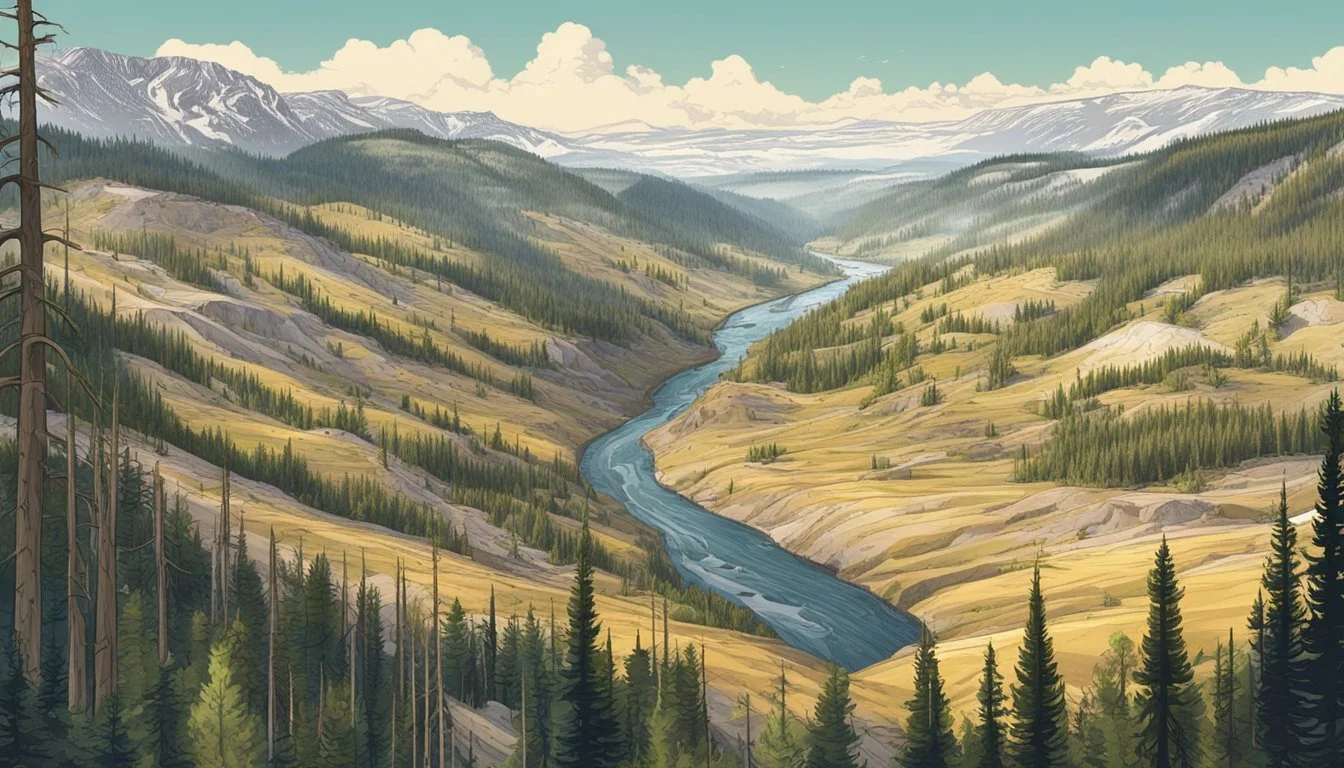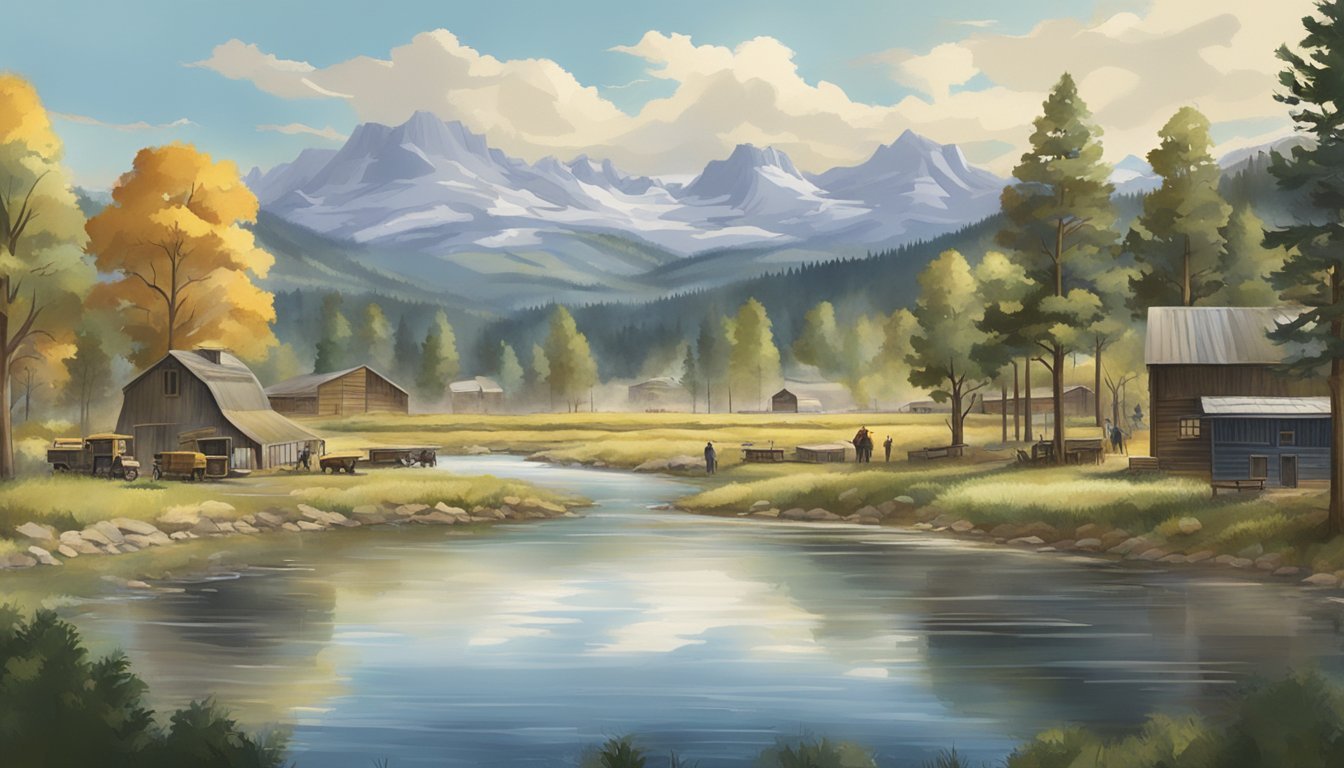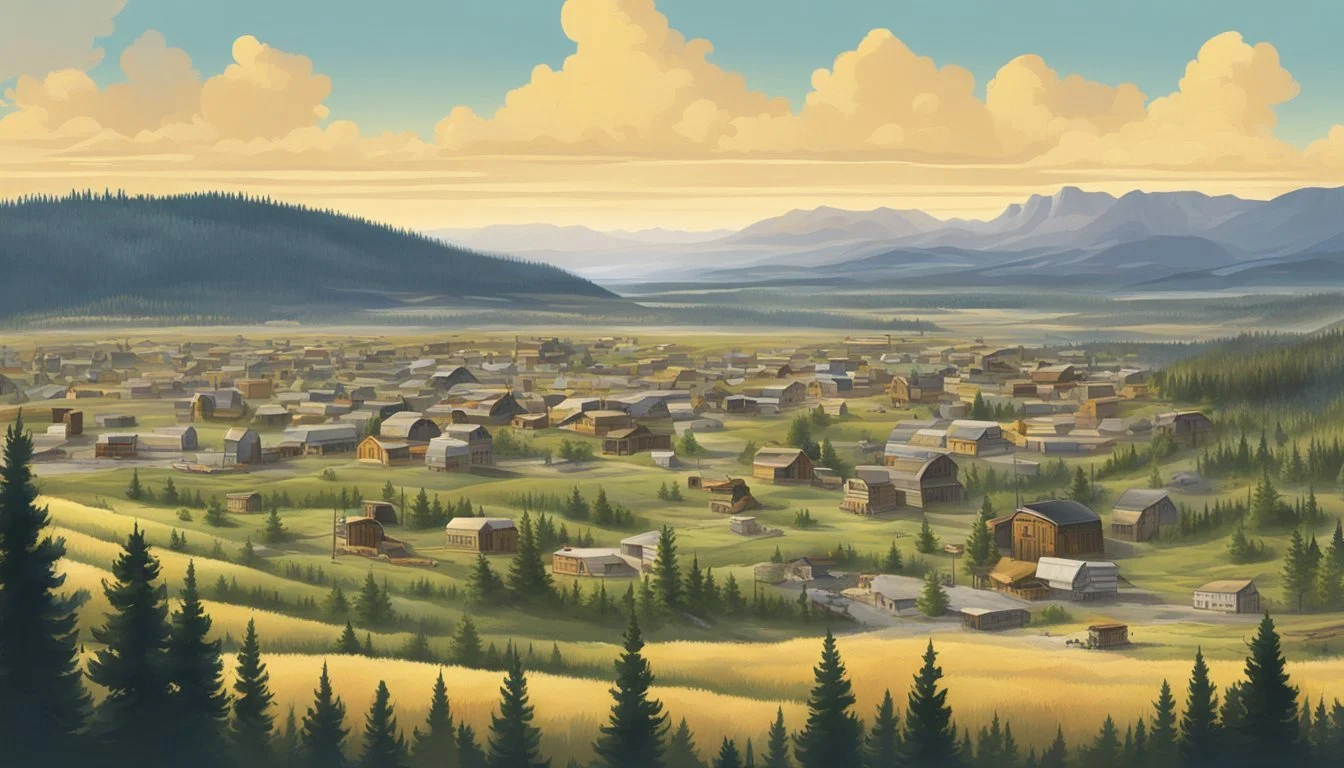Corporate America vs. Rural Values: A Central Conflict in Yellowstone
Examining the Clash of Cultures in Modern Montana
Yellowstone, the hit TV series starring Kevin Costner, masterfully portrays the clash between Corporate America and rural values in modern-day Montana. The show's creators have tapped into a deep-seated tension that resonates with viewers across the United States. At its core, Yellowstone explores how traditional ranching lifestyles and tight-knit communities are increasingly threatened by external forces of progress and profit.
Set against the backdrop of the sprawling Yellowstone Ranch, the series weaves a complex narrative of land ownership disputes, family loyalty, and political maneuvering. The Dutton family, led by Costner's character John Dutton, embodies the rugged individualism and fierce protectionism associated with rural American values. Their struggle to maintain control over their ancestral lands serves as a metaphor for the larger cultural conflict unfolding across the American West.
As a modern Western, Yellowstone updates familiar genre tropes for a contemporary audience. The show's popularity stems from its ability to address current issues such as land use conflicts, resource management, and the changing face of rural economies. By pitting the Duttons against corporate interests and government agencies, Yellowstone captures the zeitgeist of a nation grappling with rapid social and economic change.
Setting the Scene: 'Yellowstone' and the American West
'Yellowstone' depicts a modern Western landscape where traditional ranching clashes with corporate interests. The show brings the iconic American West to life, showcasing its enduring cultural significance and contemporary challenges.
Overview of the Yellowstone TV Show
'Yellowstone' follows the Dutton family, led by John Dutton (Kevin Costner), as they fight to maintain control of their vast Montana ranch. Set in Paradise Valley, the series explores conflicts between ranchers, land developers, and Native American tribes.
The show blends classic Western elements with modern issues. It tackles themes of land preservation, family legacy, and the changing face of the American West. 'Yellowstone' has gained immense popularity for its portrayal of rugged individualism and complex power dynamics.
The Significance of the American West in Culture and Media
The American West holds a special place in cultural imagination. It represents freedom, opportunity, and untamed wilderness. This romanticized vision has long captivated audiences through literature, film, and television.
'Yellowstone' taps into this fascination while presenting a more nuanced view. It showcases the beauty of Montana's landscapes alongside the harsh realities of modern ranching. The show highlights ongoing debates about land use, conservation, and indigenous rights.
By setting these conflicts in the iconic Western setting, 'Yellowstone' connects current issues to America's frontier history. It reminds viewers of the West's enduring influence on national identity and values.
Historical Context of the Dutton Family Saga
The Dutton family's journey spans generations, beginning with their arduous trek westward and culminating in their powerful ranching dynasty. Their story intertwines with the changing landscape of rural Montana and the challenges of preserving traditional values.
The Dutton Family's Roots in '1883'
James and Margaret Dutton embarked on a perilous journey from Texas to Montana in 1883. They faced harsh conditions and numerous obstacles as they sought to establish a new life on the frontier. Their young son John, who would later become a pivotal figure, witnessed the family's struggles firsthand.
The Duttons' determination led them to settle in Paradise Valley, Montana. Here, they laid the foundation for what would become the sprawling Yellowstone Ranch. This period showcased the family's resilience and set the stage for their future conflicts with encroaching modernization.
The Evolution of the Dutton Family Legacy
As the Dutton legacy grew, so did their influence in Montana. John Dutton, once a child on the wagon train, became the patriarch of a vast ranching empire. The family's connection to the land deepened with each passing generation, shaping their values and driving their actions.
The Yellowstone Ranch expanded under the Duttons' stewardship, becoming a symbol of the American West. However, this growth also brought new challenges. The family found itself increasingly at odds with corporate interests, government regulations, and changing societal norms.
Their struggle to maintain their way of life in the face of progress became a central theme. The Duttons' history of hard-won success fueled their fierce protection of their land and lifestyle, setting the stage for the conflicts portrayed in "Yellowstone."
Analyzing Land Use and Property Rights
Land use and property rights form the core of conflicts in rural America. Complex regulations and competing interests shape how land can be utilized and resources allocated.
The Dynamics of Ranches and Private Land
Ranches represent a traditional form of land use in the American West. Large tracts of private land allow ranchers to graze cattle and maintain their way of life. Property boundaries play a crucial role in defining ownership and usage rights.
Ranchers often face pressure to sell or develop their land as urban areas expand. Zoning laws and land use regulations can restrict how ranchers use their property. Some areas implement conservation easements to preserve open spaces and wildlife habitat.
Conflicts arise when public interests clash with private property rights. Ranchers may resist government oversight of land management practices. Public access to scenic areas on private land is another source of tension.
Water Rights and Environmental Regulations
Water rights are critical for agricultural operations in arid regions. The prior appropriation system grants senior water rights to early users. This can lead to disputes between ranchers and growing cities that need water supplies.
Environmental regulations aim to protect endangered species and ecosystems. The Endangered Species Act restricts land use that could harm protected wildlife. Ranchers may view these rules as government overreach that threatens their livelihood.
Wetland protections limit development in certain areas. Clean water regulations affect agricultural runoff and livestock operations. Balancing conservation goals with property rights remains an ongoing challenge.
Some ranchers embrace sustainable practices that align with environmental objectives. Others resist what they see as burdensome regulations. Finding compromise between economic, cultural, and ecological priorities is key.
Conflict and Coexistence with the Natural World
Yellowstone explores the complex relationships between humans and wildlife in rural Montana. The show highlights tensions arising from competing interests for land use and resources.
Wildlife Habitat and Conservation Efforts
The Yellowstone ecosystem supports diverse wildlife, including iconic species like bison and grizzly bears. Conservationists advocate for protecting critical habitats to maintain biodiversity. The show portrays debates over land management practices that impact wildlife corridors and breeding grounds.
Ranchers and developers often clash with environmental groups over proposed projects that could fragment habitats. Scenes depict characters negotiating compromises between economic interests and preservation goals.
Efforts to reintroduce species like wolves generate controversy. Some view this as restoring natural balance, while others see threats to livestock. The series explores how different stakeholders approach conservation.
Human-Wildlife Interactions and Management
As human activity expands into wild areas, encounters with wildlife increase. Yellowstone depicts both positive and negative interactions between people and animals. Characters express awe at majestic wildlife sightings but also frustration over property damage.
Wildlife management strategies feature prominently. Park rangers implement programs to minimize conflicts, such as bear-proof food storage. Ranchers employ various techniques to protect livestock from predators.
The show examines ethical debates surrounding wildlife control measures. Hunting and culling generate passionate arguments from multiple perspectives. Characters grapple with finding humane solutions that balance human safety and animal welfare.
Human Development Management Human development management Human development management
Rural Values and Urban Expansion: The Socioeconomic Divide
The clash between rural and urban values plays out prominently in Yellowstone, reflecting broader tensions in American society. Economic disparities and cultural differences fuel an expanding rift between rural communities and urban centers.
Ranchers and the Urban-Rural Divide
Ranchers in Yellowstone embody traditional rural values, emphasizing self-reliance, hard work, and connection to the land. They face mounting pressure from urban expansion and changing economic realities. Large agricultural operations struggle to remain profitable as land values rise and urban development encroaches.
This economic strain heightens tensions between ranchers and urban newcomers. Many ranchers view urbanites with suspicion, seeing them as threats to their way of life. They resent the influx of wealthy outsiders buying up land for vacation homes or development projects.
Urban residents often misunderstand or dismiss rural concerns. Some display a disdain for rural lifestyles, viewing them as backwards or unsophisticated. This attitude widens the cultural gulf between urban and rural America.
Gentrification and the Future of Small-Market Towns
Small towns near Yellowstone increasingly face gentrification pressures. Wealthy urbanites buy property, driving up costs for longtime residents. Local businesses cater to tourist tastes, altering the character of once-rural communities.
This influx brings economic benefits but also challenges. New jobs emerge in tourism and services. However, rising costs push out some long-term residents. Traditional industries like ranching and mining decline as the economy shifts.
Cultural clashes arise between newcomers and established residents. Differing priorities create tension in local politics and community planning. Small towns struggle to balance economic growth with preserving their rural heritage and values.
Cultural Portrayals and Perspectives
Yellowstone explores the tensions between urban and rural America through its characters and storylines. The show highlights competing worldviews and representations of different cultural groups.
Red-State–Blue-State Tensions in Media Representations
Yellowstone depicts the clash between conservative rural values and liberal urban ideals. The Dutton family embodies traditional Western culture, while outside forces represent coastal elites and corporations.
The show portrays rural Montana as fiercely independent and skeptical of outsiders. Urban characters are often depicted as out of touch with rural realities.
This red-state vs blue-state dynamic resonates with many viewers. It taps into real cultural and political divides in America.
Yellowstone's popularity stems partly from giving voice to rural perspectives often overlooked in mainstream media. The show challenges stereotypical portrayals of rural America as backward or simplistic.
Native Americans and Representation in the Show
Yellowstone features prominent Native American characters and storylines. The show attempts to depict the complex relationship between tribes and white settlers in Montana.
Native characters like Thomas Rainwater are portrayed as shrewd leaders fighting to reclaim ancestral lands. The show highlights ongoing struggles over land rights and sovereignty.
Yellowstone has received praise for including Native actors and consultants. However, some critics argue it still relies on stereotypes at times.
The show explores conflicts between tribal interests and the Dutton ranch. This reflects real tensions over land use and natural resources in the West.
The Business of Television and Audience Engagement
Yellowstone's success highlights the interplay between audience appeal and television business strategies. The show's popularity has reshaped expectations for modern Western dramas and influenced broader cultural trends.
Succession and Ratings in Cable Television
Yellowstone's viewership numbers have set new standards for cable television. The show's season 5 premiere drew 12.1 million live-plus-same-day viewers, breaking records for the Paramount Network. This success has led to a franchise expansion, with prequels and spin-offs in development.
The show's popularity has sparked a resurgence in Western-themed content across various media platforms. Networks and streaming services are now investing heavily in similar productions to capitalize on this trend.
Yellowstone's impact extends beyond television. The series has influenced fashion trends, with cowboy hats and ranch-inspired clothing seeing increased demand. Tourism to filming locations has also surged, boosting local economies.
Awards and Influence on Popularity
Despite its massive viewership, Yellowstone has received limited recognition from major award ceremonies. The show earned its first Emmy nomination in 2021 for production design.
This lack of critical acclaim hasn't dampened audience enthusiasm. In fact, some viewers see the show's snubbing by award bodies as a reflection of its appeal to often-overlooked rural and working-class demographics.
The series' popularity has grown largely through word-of-mouth and social media buzz. This grassroots support has proven more valuable than traditional accolades in sustaining viewership and cultural relevance.
Yellowstone's success without major awards challenges conventional notions about prestige television. It demonstrates that audience connection can trump critical recognition in determining a show's longevity and influence.
Character Studies: Protagonists, Antagonists, and Power Struggles
The Yellowstone series showcases complex characters embroiled in fierce power struggles. John and Kayce Dutton stand as guardians of tradition, while various antagonists from the realms of business and politics challenge their way of life.
John and Kayce Dutton: Protectors of Tradition
John Dutton, the patriarch of the Dutton family, embodies the rugged individualism of the American West. He fiercely defends his vast ranch against encroaching modernization and corporate interests.
Kayce Dutton, John's son, represents a bridge between old and new. As a former Navy SEAL, he brings tactical skills to the family's conflicts.
Together, they face:
Land developers seeking to carve up their property
Native American tribes reclaiming ancestral lands
Political adversaries aiming to reshape Montana's landscape
Their struggle highlights the tension between preserving a traditional way of life and adapting to changing times.
Antagonistic Forces in Business and Politics
The Duttons' opponents come from diverse backgrounds, each representing a threat to the ranch's existence.
Key antagonists include:
Dan Jenkins: Real estate developer
Thomas Rainwater: Tribal chairman and casino owner
Market Equities: Corporate entity eyeing Yellowstone land
These characters embody the forces of progress and profit that clash with the Duttons' values. They employ various tactics:
Legal maneuvers to acquire land
Political influence to change zoning laws
Economic pressure on local communities
The resulting conflicts showcase the complex interplay between rural traditions and modern capitalist ambitions in the American West.
Political and Environmental Policy Implications
The clash between corporate interests and rural values in Yellowstone extends to political and environmental policies. Federal regulations and conservation efforts often create tension with local communities and industries.
Role of the Federal Government in Land and Wildlife Management
The U.S. Fish and Wildlife Service oversees vast tracts of land in the Yellowstone region. This federal agency implements policies that affect local ranchers, energy companies, and residents.
Federal regulations aim to protect wildlife habitats and preserve natural resources. However, these rules can limit economic activities like grazing, mining, and logging.
Some rural residents view federal oversight as government overreach. They argue for more local control over land use decisions.
The Property and Environment Research Center advocates for market-based solutions to environmental challenges. This approach seeks to balance conservation with economic development.
The Endangered Species Act and Its Impact
The Endangered Species Act (ESA) is a cornerstone of federal conservation efforts. It provides legal protection for threatened and endangered plants and animals.
ESA regulations can restrict land use and development in critical habitats. This has sparked conflicts with ranchers, farmers, and energy companies in the Yellowstone area.
Supporters argue the ESA is crucial for preserving biodiversity. Critics claim it prioritizes wildlife over human livelihoods and economic growth.
The act has helped recover species like the gray wolf and grizzly bear in Yellowstone. However, these successes have also led to new challenges in managing wildlife-human interactions.
Conclusion: The Diverse Themes of 'Yellowstone' and Their Impact on American Life
'Yellowstone' has emerged as a cultural phenomenon, captivating audiences with its complex narrative and stunning visuals of the American West. The show's exploration of land ownership, generational conflict, and the preservation of traditional lifestyles resonates deeply with viewers.
The series skillfully portrays the tension between corporate interests and rural values, reflecting real-world struggles faced by communities in areas like the Greater Yellowstone Ecosystem. This conflict serves as a microcosm for broader debates about development, conservation, and cultural identity in America.
'Yellowstone' has influenced fashion trends, sparking renewed interest in Western wear. Its popularity has also led to spinoff series, further expanding its cultural footprint.
The show's depiction of family dynamics and internal conflicts provides a relatable backdrop for viewers grappling with similar issues in their own lives. These personal struggles are set against the backdrop of a changing American landscape, both literal and figurative.
By intertwining themes of tradition, progress, and survival, 'Yellowstone' offers a nuanced portrayal of contemporary American life. Its impact extends beyond entertainment, prompting discussions about land use, environmental conservation, and the evolving nature of rural communities in the 21st century.







